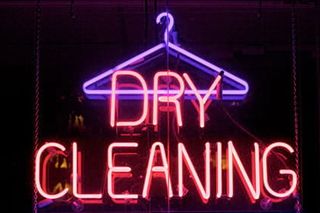
Your Dry Cleaned Clothing Is Trying to Kill You
Perc, the chemical behind dry cleaning, is a known carcinogen and neurotoxin.

Your dry cleaning is trying to kill you.
But don’t worry, it’s not personal — it’s business. Namely, it’s the affordability, availability and effectiveness of perchloroethylene that makes the known carcinogen-cum-neurotoxin the primary chemical used for dry cleaning your clothes.
Let’s back up: Dry cleaning isn’t actually dry. (I know; my mind was blown, too.) The term was coined because the method of cleaning doesn’t use water — but it does involve liquid, lots and lots of a liquid that goes by perc for short. Perc is a solvent that is phenomenal at lifting stains without damaging fabric. It’s also phenomenal at causing cancer (a fact that’s been more or less known since the ’70s) and at damaging brain cells (a more recent discovery). Yet, it continues to be the primary means of dry cleaning around the world, with few laws anywhere aimed at regulating its use or spreading consumer awareness.
That said, not every item you send for dry cleaning is treated with perc. In India, laundry services often use methods such as roll polishing, which involves washing with water; starching and steaming; five-star treatment, which utilizes the top-quality equipment of five-star hotels to wash clothing; and stain-treating, which includes a cold-water soak and stain-specific detergent. But for delicate clothing, clothing with heavy work, and deeply stained clothing, dry cleaning — aka perc baths — are often the only option. Regardless, customers are not typically informed of what method of cleaning their clothing receives.
Related on The Swaddle:
Manufacturing New Clothes Will Always Harm the Environment
And that’s a problem because studies have shown dry cleaned clothing retains perc in its fibers — and the levels of perc increase with each successive cleaning of a garment, especially of wool garments. (Silk, on the other hand, retains only trace amounts of perc.) In 2011, “researchers calculated what they thought would happen if four freshly cleaned wool sweaters were put inside a warm car with the windows closed for an hour: The perc vaporized from the sweaters would produce a level [of breathable perchloroethylene] as high as 126 parts per million, which exceeds the workplace exposure limits set by the [United States] Occupational Safety and Health Administration, and far exceeds tighter limits more widely recommended by industry and government scientists,” reported The Washington Post in 2011.
Industry critics point out that at least one of these studies tested clothing that had not been steam pressed, a process they say helps remove residual perc from fibers. Researchers counter that steam pressing simply serves to vaporize the solvent into the air we breathe — and note that industry insiders have previously argued that pressing garments doesn’t increase perc levels in indoor air, suggesting that clothes do retain perc.
“It doesn’t just disappear,” one critic told the newspaper at the time.
Even if perc does vaporize into the air, that’s a problem, too, since, you know — we breathe it. Just a few hours of exposure to airborne perc can cause vision problems and cognitive impairment. A few more hours of exposure can cause headaches, dizziness and balance. While these symptoms resolve once exposure ends, long-term exposure to airborne perc of the kind experienced by dry cleaning workers can affect cognition, immunity and cause liver and kidney damage, among other fallout.
And that’s outside of the gross environmental damage perc can cause by seeping into ground water — which then becomes our drinking water.
Still, around 70 percent of dry cleaners in the U.S. continue to use perc. It feels safe to assume in India, which has far fewer consumer and environmental protection laws, that number is closer to 100 percent. India’s laundry industry is worth USD 76.5 billion and expected only to grow as urban centers proliferate. There’s money in dry cleaning; there’s even more money in dry cleaning with perc, which as the established method is more affordable and available for businesses. Switching to alternative laundry treatments is costly.
But alternatives do exist — namely, wet cleaning. “Smart wet cleaning machines can precisely time washing and drying, ensuring wool, silk, and other sensitive fabrics are free from spots and damage. The water-based systems also allow operators to use safer detergents and solvents, derived from things like fungi microbes instead of PERC,” reported PopSci last year. And India has a chance to take a cue from U.S. states like California, which is in the process of phasing out the solvent by 2023.
Until it does, however, maybe limit your wardrobe to pieces that don’t require dry cleaning. Or dress entirely in silk.
Liesl Goecker is The Swaddle's managing editor.
Related


Women’s Mental Load Linked to Distress, Dissatisfaction, Study Finds
